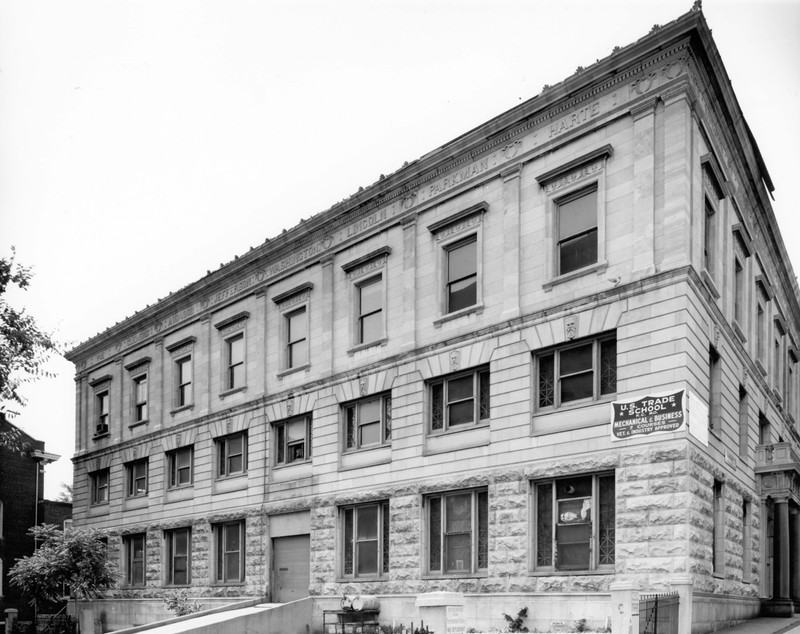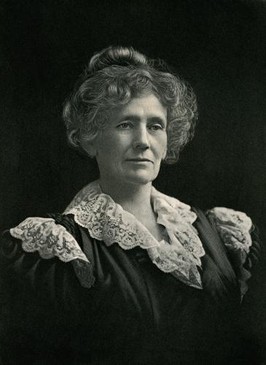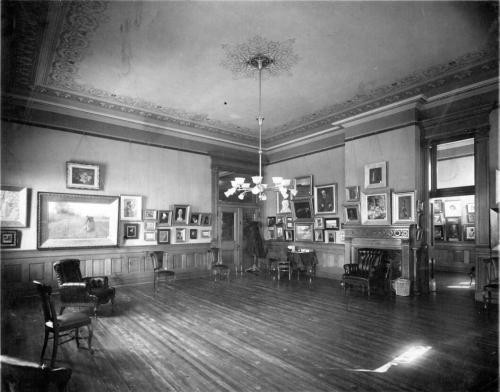Kansas City's Second Public Library (1897-1960); Ozark National Life Building
Introduction
Text-to-speech Audio
This downtown building was constructed to hold the growing collection of the Kansas City Public Library and opened in 1897. The Second Renaissance Revival style building replaced a smaller and simpler two-story structure that opened in 1889 and was located just one block away at 8th and Oak. This new building was completed at a cost of $200,000, twenty times the cost of the previous building, and was home to both the public library and the offices of the Kansas City Board of Education until 1960. At its opening, the library held a dedicated children's area, which is believed to be the first of its kind in the United States. This building was also home to the first art gallery of William Rockhill Nelson until the Nelson-Atkins Museum of Art at 45th and Oak Streets was completed. In 1960, the library and the school board moved to a newly constructed modern building at 12th and McGee. In 1988, the library and school board became separate entities but continued to share the same building at 12th and McGee until 2004, when the library's central branch moved to the former First National Bank building at 10th and Baltimore. The Board of Education left that building in 2017, and that former shared structure was demolished three years later. This building, however, continues to be occupied. The structure served as the home to the U.S. Trade Schools Inc. from the library's departure in 1960 until the 1980s. The building is now home to Ozark National Life Insurance Company.
Images
Kansas City's Second Public Library

Carrie Westlake Whitney, the first full-time librarian, was hired in 1881 and oversaw the transition to this structure

The library was home to the Western Gallery of Art which later became the Nelson-Atkins Museum of Art

Backstory and Context
Text-to-speech Audio
The city's library, then known as the Public School Library, was held in five offices that were home to the city's school board in the 1870s and 1880s. In 1889, the completion of a simple two-story storefront at 8th and Oak was celebrated as the first purpose-built home for the library's growing collection overseen by Carrie Westlake Whitney, the first full-time librarian who was hired in 1881 and served the library for over thirty years.. This building became the second purpose-built home of Kansas City, Missouri's public library eight years later. As the city was expanding rapidly in the late 20th century, it became evident that there was a need for a larger library to match its new metropolitan status. Thus, for $200,000, this structure was built for the library which was under the jurisdiction of the public school system. The building was also home to the administrative offices of the Kansas City Board of Education.
The city continued to grow, and in 1914, the first branch located near a Black community opened in Garrison Field House . In 1916, this library building was expanded, doubling the floor space for another cost of $200,000. Kansas City quickly realized that the best way to serve the rapidly growing city was to continue to invest in branch libraries. The first branch was added with the annexation of the previously-independent city of Westport in 1899. By 1930, there were 19 branch libraries in the city, although most of these were located in public schools. Another reason for the expansion of the building was the burgeoning art gallery, donated by newspaper publisher William Rockhill Nelson. Nelson believed his efforts to acquire original, artistically, and historically significant works of art would accelerate the library’s aim in transforming the culture of Kansas City from a frontier outpost to that of a 20th-century metropolitan society. Nelson made so many contributions to the art gallery that the library often found itself running out of room to showcase the artwork.
The library and school board moved to a newly-constructed modern building in 1960, and the U.S. Trade Schools Inc. would move in not long after. U.S. Trade schools would hold the space for two decades. During this time, the first floor was designed as a diesel transmission shop. Many of the auxiliary rooms were converted into classrooms as well. Elevators designed for cars were also installed. By the mid-1980s, the space was bought out again, this time by the present owner – Ozark National Life Insurance Company. The building now bears this name on its 9th Street façade, just above the historic entryway for the public library. This is one of the many ways in which the historic integrity of the building has been maintained even after its time as a trade school and current time as an insurance agency.
The exterior of the building carries the hallmarks of the turn of the century architecture. The main entrance, which faces 9th Street, is a great example of the style, with its two pedestals carrying marble pillars. Six more marble pillars are located on the second floor, decorating a patio area above the entrance. This is one of the many ways the building demonstrates the Second Renaissance Revival style, which was popular at the end of the 19th century. It was this architecture style that symbolized the desire for the city to seen as a true metropolitan center at the end of the 1800s.
Sources
Hoffman, William H. Swovelan, Edward. KANSAS CITY, MISSOURI, PUBLIC LIBRARY, 1873-1973: AN ILLUSTRATED HISTORY. Kansas City, MO. Kansas City Public Library, 1973.
Timeline, Kansas City Public Library, https://kclibrary.org/library-history accessed June 27, 2024.
Ryder, Elaine B. NATIONAL REGISTER OF HISTORIC PLACES INVENTORY -- NOMINATION FORM - KC Public Library, MOStateParks. March 5th, 1976. Accessed June 14th, 2024. https://mostateparks.com/sites/mostateparks/files/KC%20Public%20Library.pdf.
Ozark National Life Building, KC History. May 5th, 2018. Accessed June 14th, 2024. https://kchistory.org/image/ozark-national-life-building.
https://www.historic-structures.com/mo/kansas_city/kansas-city-public-library/
Timeline, Kansas City Public Library, https://kclibrary.org/library-history accessed June 27, 2024.
Timeline, Kansas City Public Library, https://kclibrary.org/library-history accessed June 27, 2024.
